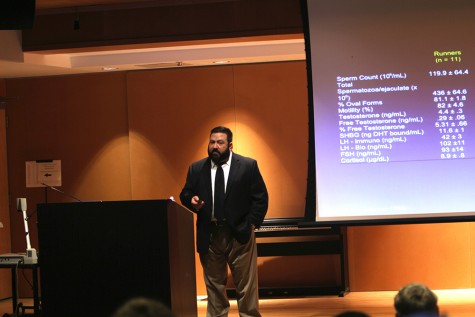Scientist talks about hormones to students, faculty
February 10, 2015
Michael Muehlenbein said hormones are the reason for many modern biological traits, including why human toddlers

Dr. Michael Muchlenbeln from Indiana University- Department of Anthropology, presents his lecture, “Hormones, Health, and Life Histories”, on Tuesday in the Doudna Lecture Hall.
basically look like lollipops.
Muehlenbein, a professor of anthropology from Indiana University, visited Eastern to help the biology department celebrate the second day of its Darwin Day series.
His lecture Tuesday night was called “Hormones, Health, and Life Histories.”
Muehlenbein said this was not his first time visiting Eastern, as one of his best friends used to attend the university.
Muehlenbein said in his studies he and his team have tried to connect the dots of some questions, such as the relationships between hormones, life-history evolution and health outcomes.
He said his topic focused more on human and non-human primates’ life history and hormones.
He said humans do not have a singular life-history trait, but rather an interesting combination of them.
Traits like post-natal brain growth and the extended period of juvenile dependency are a few of those traits he said makes humans different then other primates.
“This is why we have 4 to 5 year-olds that essentially look like lollipops, little bodies with a giant head,” he said.
Muehlenbien said the traits are not unique to humans, but what makes them unique are the fertility levels.
He said other species usually have a low fertility rate because they take a long time to get to the reproduction levels needed to properly reproduce.
Humans, however, have very high fertility levels compared to these other species.
He said there are trade offs of different traits as well.
Muehlenbein said the reason why young women, usually between the ages of 15 to 16, who are pregnant have a higher risk of having a pre-term birth and the size of the child is smaller than the average size.
“The idea here is that they are still growing and that you can’t invest optimally in grow and reproduction at the same time,” he said.
He said when he was looking at the studies of women’s reproduction rates and levels, he noticed there were not many that focused on men’s reproduction.
He said it was because he decided to study and look more into men’s hormones and reproduction levels.
During his lecture, he went more into detail of the work he has done over the years, some by himself and other stuff with his team.
Stephanie White can be reached at 581-2812 or at sewhite2@eiu.edu.




































































